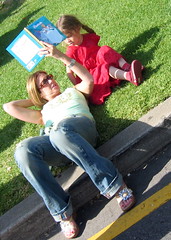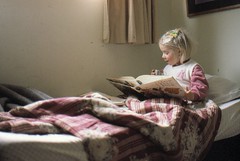Opening the newest issue of Chatelaine or Today's Parent at the doctor's office will always result in finding another article on food and nutrition. Everywhere we turn, new information crops us about a nutrient the experts want us to eat
more of or, more likely, something they want us to eat
less of.
As a society, we are obsessed with eating. The amazing thing is that with all this 'expert' information about food and nutrition, our population actually becomes more malnourished, overweight and unhealthy. Tragically, while experts are essential for more complicated subjects, relying on them to replace commonsense will always yield problems. Commonsense can not be broken down by science.
When you take a step back and think about it, isn't it bizarre that we actually need scientists to tell us how and what to eat?!In the last year or two, I have done a lot of thinking about our diet. We have always had a very healthy diet, with a minimum of processed or convenience foods and only a rare meal out. However, I had definitely fallen trap to
'nutritionism'. Nutritionism assumes that you can take nutrients out of the context of food, rearrange them, in the form of vitamins or 'added value' products, and consume them for a healthy diet. The trouble is that humans are not all-knowing. We are always discovering new things and we really have no idea what we don't know. A healthy diet cannot be artificially created by combining the right nutrients. Even if it could, we have no idea what nutrients we have not discovered yet. In addition, we have, truly, no idea of the way different parts of food are supposed to work together. I think this Bible verse really speaks to our belief, as humans, that we can begin to understand the complexities of God's creation enough to try to rearrange what He has made:
For in measuring themselves by themselves, and comparing themselves among themselves, they are not wise.
2 Corinthians 10:12
This is an excellent verse for all kinds of situations in life. It reminds us that because we are humans, not God, we cannot accurately assess our own situation independent of Him. A friend gave the analogy of a fish in water. How does a fish know that it is wet? We are the fish here.
I, personally, am done listening to the experts and I have returned to commonsense. Our family has decided to put our trust in God and the way He has created food. One of
La Leche League's 10 core concepts is an excellent statement on food, which I think sums up our family's philosophy well: "Good nutrition means eating a well-balanced and varied diet of foods in as close to their natural state as possible." That's it.
So, what does this mean for our family? For us, it means that in general, we make food from scratch. We are not concerned with what is not in food (low fat, for example) because we just eat food straight-up, not boxes or bags of things someone else has made. I only do one big-ish shopping trip to the grocery store about once a month, but even then I don't buy much. Why not? Because the majority of what is at the grocery store is not real food. It is substances that used to be food rearranged into something else.
Basically, if it comes from a factory, we avoid it. (Not that we don't eat it
ever. Don't get me wrong. This is our
general policy.) We also don't put any stock in whether or not factory-made products come from the health food store. Organic whole wheat noodles with powdered cheese are still not real food. I believe these foods are a slight improvement over their grocery-store counterpart, but I don't rely on them to feed our family or convince myself that they can compare to food.
So, where do I shop, then?
- Steve and I make a weekly trip to the local Farmer's Market. We are very blessed to have a market that is open all-year. We try hard to eat seasonally and shopping at the market makes this possible. There is such joy in getting that first bushel of apples in the fall or in spotting the first asparagus of the spring.
- Next, we patronize a local organic, biodynamic farm. There, we have a CSA share both in the winter and the rest of the year. This provides the majority of veggies we need. We also purchase things like wheat, honey, eggs and meat from them.
- Once a month, I order from a health food co-op. This provides us with things like tea, dried fruit, some dried legumes, cream (that has only cream listed as the ingredient!), and the few factory foods that we still eat, such as wraps and crackers.
- And, as mentioned, I do a bigger shopping at the grocery store once a month and run to the natural food store for coffee cream and sour cream once in awhile.
I try hard to be as frugal as possible with our food choices without compromising our principles. It is my goal to nourish our family and invest in our health, not to try to get the cheapest food possible at all times. Because our budget is not limitless, this means that we don't get to have swiss cheese on our sandwiches very often or eat yummy steaks more than once or twice a year. It does mean, though, that we are very rarely sick and that our food almost always tastes
great. It has been a joy to rediscover food as food and to be free from micro-managing our diet.
Can I recommend some great reading to you, if you are interested in learning more?
Michael Pollan has written some fantastic books. His most recent book,
In Defense of Food had me saying, "YES!" out loud on more than one occasion. It is definitely worth 'devouring' and is almost certainly available at your local library. I would also recommend
Real Food by Nina Planck,
Animal, Vegetable, Miracle by Barbara Kingsolver and
The End of Food by Thomas Pawlick (this one is Canadian).
Happy Eating!
 Photo courtesy of fortinbras
Photo courtesy of fortinbras



















